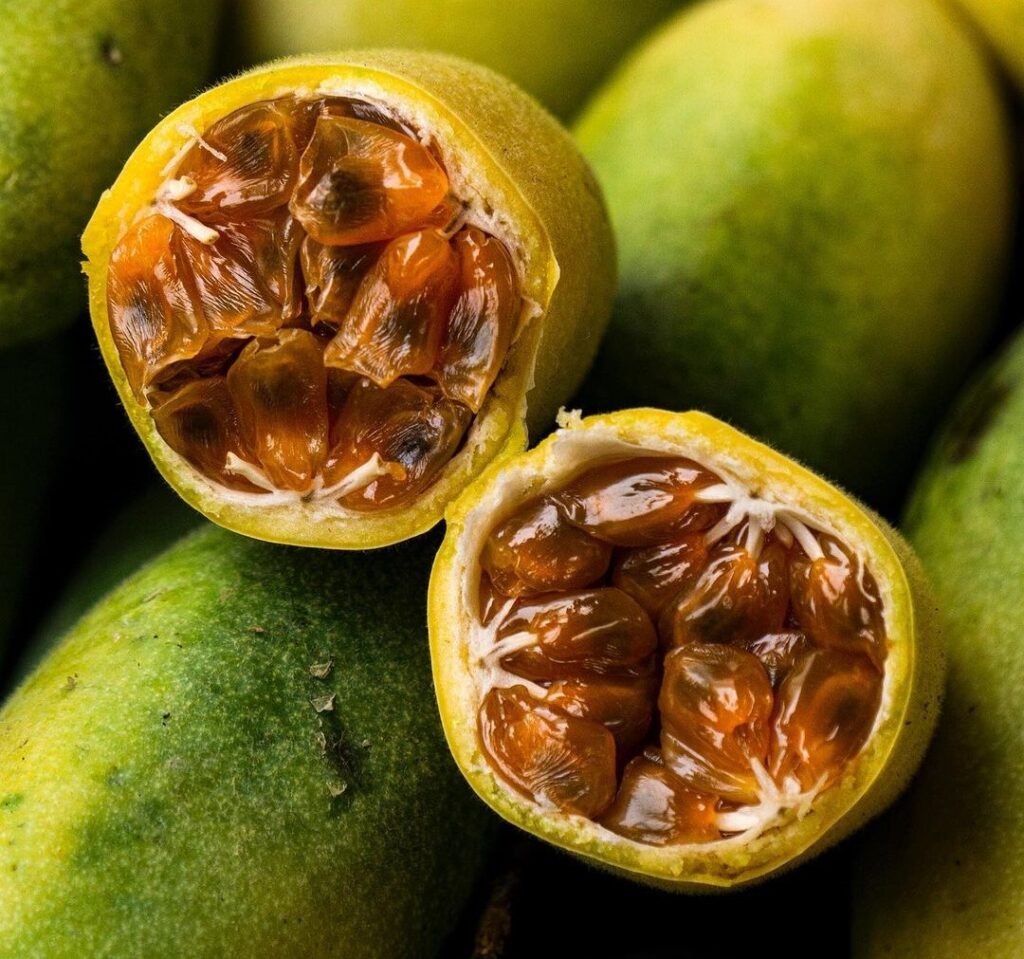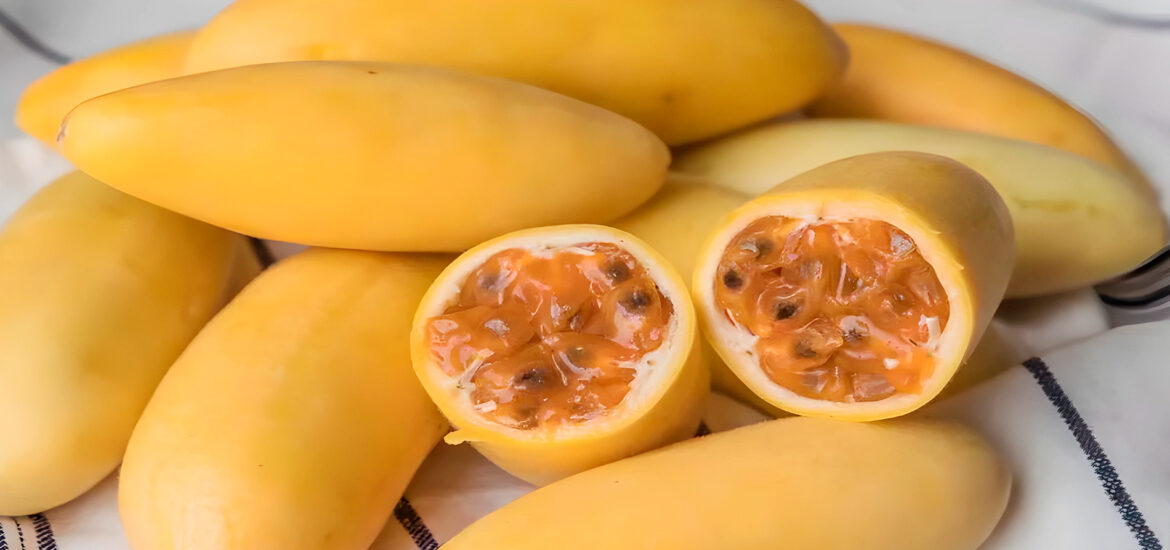Tumbo, also known as Banana Passionfruit, is a citrus native fruit that grows in the Peruvian Andes Mountains. Grown at altitudes between 1,200 and 3,000 meters above sea level, this vibrant fruit shares similarities with the passion fruit (Maracuya). Tumbo is a must-try for fruit lovers that shows Peru’s incredible biodiversity. Health enthusiasts will love it too.
Rich in nutrients, Tumbo offers many health benefits. But beyond its nutritional value, the Tumbo holds historical significance. During the Inca Empire, this fruit played a vital role in ancient Peruvian culture. Let’s dive into the fascinating history and benefits of the Tumbo fruit!
Tumbo’s brief history
Tumbo’s scientific name is “Passiflora tripartita”, is a delicious cousin of the passionfruit. When ripe, its outer skin is smooth and bright yellow. Inside, you will find a tasty surprise—juicy, orange pulp filled with small black seeds. Tumbo thrives in high-altitude areas, usually between 2,000 and 3,500 meters above sea level.
Thanks to the cool climate, tumbo flourishes quickly. People adore this fruit for its tangy, sweet-and-sour flavor. It’s perfect for making refreshing juices, delicious desserts, and even savory dishes. This fruit is also very versatile and plays an important role in cooking and traditional medicine in other South American countries.
Even centuries before the Incas, pre-inca cultures like the Mochicas used tumbo instead of lemons. They mixed the tumbo or extracted its juice with fish, creating the pioneer of ceviche, Peru’s most emblematic dish.

Although Peruvians use lemon to eat ceviche, tumbo is still useful in Peruvian cuisine. Tumbo has been a part of Andean life for thousands of years. Ancient peoples like the Incas, valued it for its flavor and medicinal properties.
Incas used it to make refreshing drinks and as an offering to their gods. Thanks that they were talented farmers, they could cultivate other native crops, such as quinoa, potatoes, etc.
Tumbo holds a special place in their culture as it represents their strong bond with the land and their appreciation for nature’s gifts. Even after the Spanish arrived in the 1500s, this fruit continued to be an important part of Andean life. Today, we still celebrate tumbo as a beloved traditional fruit, valued for its delicious taste and rich history.
Why is Tumbo Important?
Tumbo is more than just a fruit; it plays a significant role in Andean life:
Sustainability: Tumbo grows naturally in its native environment, requiring minimal water and fertilizer. This makes it an eco-friendly crop that supports local farmers and protects the environment.
Cultural Heritage: For the Andean people, tumbo is a connection to their ancestors and traditions. It is often used in celebrations and local dishes, preserving its cultural importance.
Health Benefits: Tumbo is packed with vitamins, antioxidants, and other nutrients that support a healthy lifestyle.
Health Benefits of Tumbo
Tumbo isn’t just delicious—it’s incredibly good for you! Here’s how:
Rich in Vitamin C: One of tumbo’s most significant nutrients it’s vitamin C. It boosts the immune system, helping your body fight off colds and other illnesses. It also acts as an antioxidant, protecting your cells from damage caused by free radicals.
For kids, tumbo keeps their immune system strong and supports growth. On the other side, grown-ups can benefit consume it. This fruit promotes healthy skin, improves wound healing, and supports overall health.

High in Fiber: The seeds and pulp of tumbo are loaded with dietary fiber, which helps with digestion and keeps your gut healthy. Fiber also prevents constipation and helps regulate blood sugar levels. This fruit also has low calories which is a good ingredient for vegetarian or vegan diets.
Packed with Vitamin A: Tumbo contains a good amount of vitamin A, which is essential for healthy vision, skin, and immune function.
For the Eyes: Protects your eyesight and reduces the risk of eye-related conditions as you age.
For the Skin: Promotes healthy, glowing skin and helps repair damage.
Other health Benefits
Supports Heart Health: The antioxidants and nutrients in tumbo, like potassium, help maintain healthy blood pressure and reduce the risk of heart disease.
Antioxidants: Fight inflammation and reduce bad cholesterol levels.
Potassium: Helps regulate blood pressure by balancing sodium levels in the body.

Energy Boost: Tumbo’s natural sugars provide a quick energy boost, making it a perfect snack for kids and active adults. Unlike processed sugary snacks, tumbo delivers energy alongside important nutrients.
Good for the Nervous System: The calming properties of tumbo are believed to reduce anxiety and promote relaxation. It has been used in traditional medicine to help with stress and insomnia.
Fun Fact: Eating fiber-rich foods like this one can help you feel full longer, which is great for maintaining a healthy weight.
How to Use Tumbo
Tumbo is incredibly versatile in the kitchen. Here are a few popular ways to enjoy it:
Juices and Smoothies: Take the pulp of some pair of tumbos, then blend it for some seconds. Then, add half a liter of water and strain the mix. Put the drink in a jar, add cold water, sugar to taste, the juice of one lemon, and finally sugar to taste. Voila, you have your tumbo juice ready to enjoy!

Desserts: Peruvians show their creativity using tumbo for jams, ice creams, or recently with cheesecakes or mousses. We highly recommend these desserts when you visit Peru.
Sauces: In Peruvian gastronomy, this fruit is quite useful. The tumbo sauce combines with pig, fish, or meat-based dishes. Tiradito, a seafood similar to the Japanese sashimi, goes well with a bittersweet tumbo sauce.
Cocktails: Recently in Peru, the tumbo has been practical for making delicious cocktails like tumbo sour.
In Andean medicine, tumbo is also used to treat upset stomachs and fevers, thanks to its natural calming and cooling properties.
Tumbo in Modern Times
Tumbo has recently caught the eye of food lovers outside the Andes, showing up in gourmet recipes and international markets. As more people seek out unique and healthy foods, tumbo’s popularity is on the rise. Even with its growing appeal in global cuisine, tumbo stays closely connected to Andean traditions.

It is valued not just for its delicious flavor but also for its cultural importance and health benefits. Tumbo is more than just a fruit; it represents Andean heritage, provides nourishment, and adds a tasty element to any meal.
With its rich history, eco-friendly qualities, and various health perks, it’s a fantastic choice for anyone wanting to explore exotic fruits or enhance their diet. Whether you enjoy it in juice, as a snack, or as dessert, tumbo brings a taste of the Andes and a boost of nutrition.
So, the next time you spot this vibrant fruit, give it a try! You’ll be savoring not just a treat, but a piece of Andean culture and history. To learn more about Peruvian superfoods like Tumbo, keep reading Viagens Machu Picchu’s blog!
Keep in mind that we’ll be more than glad to assist you in discovering our beautiful country and all of its mysteries. Contact us to take the first step into your adventure, Peru, the country of the tumbo is waiting for you to discover it!
Viagens Machu Picchu, journeys that inspire, moments that last.

